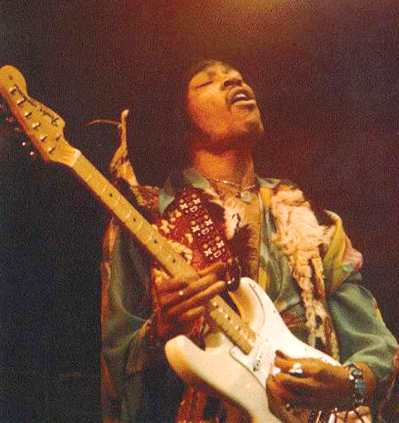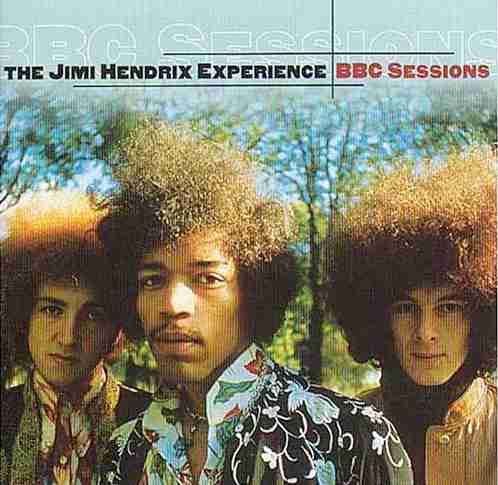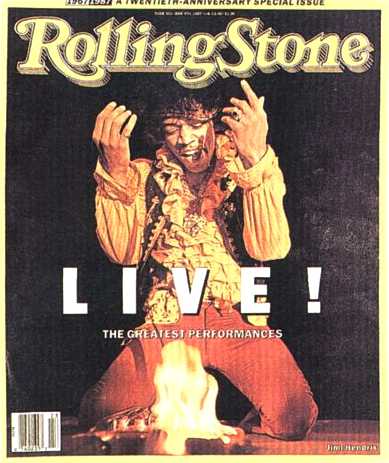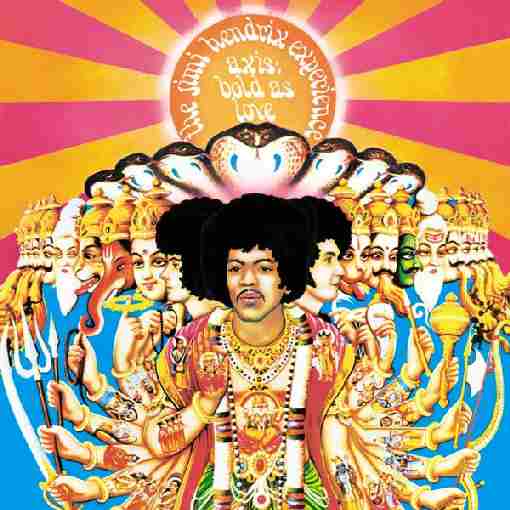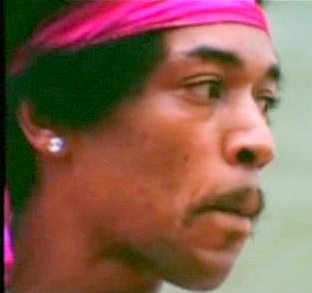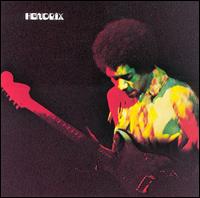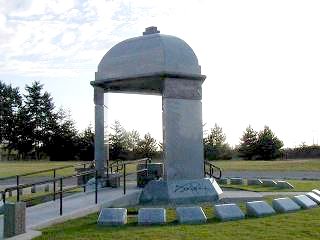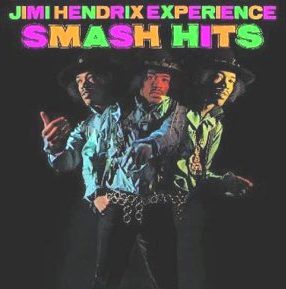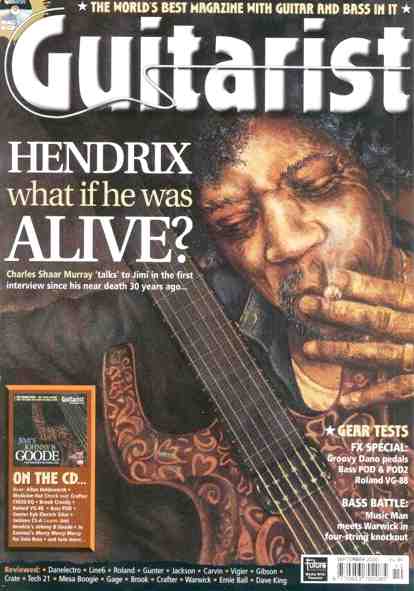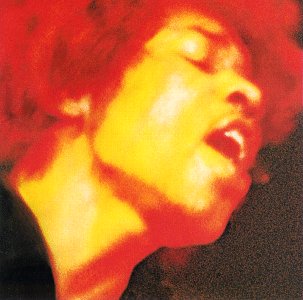|
JIMI HENDRIX
|
|||
|
HOME | BIOLOGY | FILMS | GEOGRAPHY | HISTORY | INDEX | INVESTORS | MUSIC | SOLAR BOATS | SPORT |
|||
|
Jimi Hendrix (November 27, 1942, Seattle, Washington – September 18, 1970, London, England) was an American guitarist, singer and songwriter. Hendrix is recognized as one of the greatest and most influential guitarists in rock music history. After initial success in England, he achieved worldwide fame following his 1967 performance at the Monterey Pop Festival. Later, Hendrix headlined the iconic 1969 Woodstock Festival before his death in 1970, at the age of 27.
Jimi Hendrix and his Fender Statocaster
A self-taught musician, Hendrix played a Fender Stratocaster guitar turned upside down ("left-handed") and restrung to suit him. Hendrix pioneered the technique of guitar feedback with overdriven amplifiers, incorporating what was previously an undesirable sound into his music. He built upon the innovations and influences of blues stylists such as B.B. King, Muddy Waters, Albert King, and T-Bone Walker, and derived style from rhythm and blues and soul guitarists Curtis Mayfield, Steve Cropper, and Cornell Dupree, as well as from traditional jazz. Part of Hendrix's flamboyant stage persona may have been inspired by rock pioneer Little Richard, with whom he toured as part of Richard's back-up band, "The Upsetters".
Hendrix strove to combine what he called "earth", a blues, jazz, or funk driven rhythm accompaniment, with "space", the high-pitched psychedelic sounds created by his guitar improvisations. As a record producer, Hendrix also broke new ground in using the recording studio as an extension of his musical ideas; he was one of the first to experiment with stereophonic and phasing effects during recording.
Hendrix was inducted into the Rock & Roll Hall of Fame in 1992 and the UK Music Hall of Fame in 2005. His star on the Hollywood Walk of Fame (at 6627 Hollywood Blvd.) was dedicated in 1994. In 2006, his debut album, Are You Experienced, was inducted into the United States National Recording Preservation Board's National Recording Registry. Rolling Stone named Hendrix number 1 on their list of the 100 Greatest Guitarists of All Time in 2003.
Biography
Early life
Johnny Allen Hendrix (later re-named James Marshall Hendrix) was born on November 27, 1942 in Seattle, Washington. Hendrix's parents divorced when he was nine years old, and in 1958 his mother died. He went to live with his grandmother because of his unstable household. Hendrix did not graduate from high school. Hendrix later claimed that he was expelled for holding hands with his white girlfriend, but when questioned later, his principal insisted that it was due to poor grades and frequent absences. Hendrix got into trouble with the law twice for riding in a stolen car. He was given a choice between spending two years in prison or joining the army. Hendrix chose the latter and enlisted on May 31, 1961. After completing boot camp he was assigned to the 101st Airborne Division and stationed in Fort Campbell, Kentucky. His commanding officers considered him to be a sub-par soldier: he slept while on duty, had little regard for regulations and showed no skill as a marksman. He was given an early release from military service in Fort Campbell, Kentucky for "behavioral problems", though rumors held that he faked homosexuality or was given a medical release for breaking his ankle while parachuting.
Early career
After his release, Hendrix and army friend Billy Cox moved to nearby Clarksville, Tennessee, where they formed a band called The King Kasuals. Playing in low-paying gigs at obscure venues, the 'band' eventually moved to Nashville. Playing and sometimes living in the clubs along Jefferson Street, the traditional heart of Nashville's black community and home to a lively rhythm and blues scene offered some sort of 'existence'. In November 1962, Hendrix participated in his first studio session, where his wild but still undeveloped playing found him cut from the soundboard.
For the next three years, Hendrix made a precarious living on the Chitlin Circuit, performing in black-oriented venues throughout the South with both the King Kasuals and in backing bands for various soul, R&B, and blues musicians, including Chuck Jackson, Slim Harpo, Tommy Tucker, Sam Cooke, and Jackie Wilson. The Chitlin Circuit was an important phase of Jimi's career, since the refinement of his style and blues roots occurred there. His work garnered him little fame or profit, and the extremes of racism and poverty that he endured left an indelible mark on his memories of this era.
Frustrated by his experiences in the South, Hendrix decided to try his luck in New York City. Jimi was always inspired by a saying he once heard from his grandmother: "I want to need to have you. First I have to need to want you." In January 1964, he moved to Harlem, where he quickly befriended Lithofayne "Fayne" Pridgeon (who later became his girlfriend) and the Allen twins, Arthur and Albert (now known as Taharqa and Tunde-Ra Aleem). The Allen twins quickly became loyal friends who kept Hendrix out of trouble in New York. The twins also performed as backup singers (under the name Ghetto Fighters) on some of his recordings, most notably the funk anthem "Freedom". Pridgeon, a beautiful Harlem native with connections throughout the area's music scene, provided Hendrix with shelter, support, and encouragement during the poorest and most desperate years of his life. In February 1964, Hendrix won first prize in the Apollo Theater amateur contest. The win was encouraging, but in general he found breaking into the New York scene difficult.
In 1965, Hendrix earned a spot as the new guitarist for the The Isley Brothers' band and joined their national tour, which included the southern Chitlin Circuit. Hendrix played his first successful studio session on the two-part Isley Brothers hit "Testify". In Nashville, he left the Isleys to tour with Gorgeous George Odell. In Atlanta, he earned a spot in the backing band of Little Richard, The Upsetters. Although Hendrix idolized Richard, he clashed frequently with the star over tardiness, wardrobe, and, above all, Hendrix's flashy stage antics. For a short while, Hendrix quit and toured with Ike and Tina Turner, but was quickly fired for playing wild guitar solos and returned to Little Richard's band. Months later, he was banished from The Upsetters after missing the tour bus in Washington, D.C.. Around this time he refined his flamboyant guitar stage style, much of which was influenced by Johnny "Guitar" Watson.
In 1965, Hendrix joined a New York-based band, Curtis Knight and the Squires, after meeting Knight in the lobby of a seedy midtown hotel where both men were living at the time. Hendrix then toured for two months with Joey Dee and the Starliters before rejoining the Squires in New York. On October 15, 1965, Hendrix signed a three-year recording contract with entrepreneur Ed Chalpin, receiving $1 and 1% royalty on records with Curtis Knight. While the relationship with Chalpin was short-lived, his contract remained in force, which caused considerable problems for Hendrix later on in his career. The legal dispute was eventually settled.
In 1966, Hendrix formed his own band, Jimmy James and The Blue Flames, composed of various friends he would casually meet at Manny's Music Shop, including a 15-year old runaway from California named Randy Wolfe. Since there were two musicians named "Randy" in the group, Hendrix dubbed Wolfe "Randy California" and the other "Randy Texas". Randy California would later co-found the band Spirit with Ed Cassidy.
Hendrix and his new band quickly gained local attention and played throughout New York City, but their primary spot was a residency at the Cafe Wha? on MacDougal Street in the West Village. During this period, Hendrix met and worked with singer-guitarist Ellen McIlwaine and guitarist Jeff "Skunk" Baxter, who was an employee at Manny's. Hendrix also met Frank Zappa during this time, who is credited as having introduced Hendrix to the newly-invented wah-wah pedal.
The Jimi Hendrix Experience on the cover of the compilation album BBC Sessions 1998
The Jimi Hendrix Experience
Early in 1966 at the Cheetah Club on West 21st Street, Linda Keith, the girlfriend of Rolling Stones guitarist Keith Richards, befriended Hendrix and recommended him to Stones manager Andrew Loog Oldham and producer Seymour Stein. Neither man took a liking to Hendrix's music, however, and they both passed. She then referred him to Chas Chandler, who was ending his tenure as bassist in The Animals and looking for talent to manage and produce. Chandler was enamored with the song "Hey Joe" and was convinced that he could create a hit single by remaking it into a rock song.
Impressed with Hendrix's version, Chandler brought him to London and signed him to a management and production contract with himself and ex-Animals manager Michael Jeffery. Chandler then helped Hendrix form a new band, The Jimi Hendrix Experience, with guitarist-turned-bassist Noel Redding and drummer Mitch Mitchell, both British musicians. Shortly before the Experience was formed, Chandler introduced Hendrix to Eric Clapton, who had only recently formed Cream. At Chandler's request, Cream let Hendrix join them on stage for a gig. Hendrix and Clapton remained friends up until Hendrix's death.
UK success
After a number of European club appearances, word of Hendrix spread through the London music community. His showmanship and virtuosity made instant fans of reigning guitar heroes Eric Clapton and Jeff Beck, as well as members of The Beatles and The Who, whose managers signed Hendrix to The Who's record label, Track Records.
Hendrix's first single was a cover of "Hey Joe", crafted after folk-singer Tim Rose's slower revision of the song and adapted to Hendrix's emerging style. Backing the first single was Jimi's first songwriting effort, "Stone Free". Further success came with "Purple Haze" and "The Wind Cries Mary". The three singles were all UK Top 10 hits. Onstage, Hendrix was also making a huge impression with fiery renditions of the BB King hit "Rock Me Baby" and an ultra-fast revision of Howlin Wolf's blues classic, "Killing Floor".
Are You Experienced?
The first Jimi Hendrix Experience album, Are You Experienced, was released in the United Kingdom on May 12, 1967. It contained no previous UK singles or any B sides ("Hey Joe/Stone Free", "Purple Haze/51st Anniversary" and "The Wind Cries Mary/Highway Chile"). Only The Beatles' Sgt. Pepper's Lonely Hearts Club Band prevented Are You Experienced from reaching No. 1 on the UK charts.
At this time, the Experience extensively toured the United Kingdom and parts of Europe. This allowed Hendrix to develop his stage presence, which reached a high point on March 31, 1967, when he set his guitar on fire. Later, after causing damage to amplifiers and other stage equipment at his shows, Rank Theatre management warned him to "tone down" his stage act. On June 4, 1967, the Experience played their last show in England, at London's Saville Theatre, before heading off to America. The Sgt. Pepper's album had just been released days prior, and two Beatles (Paul McCartney and George Harrison) were in attendance at the show, along with a roll call of other UK rock stardom: Brian Epstein, Eric Clapton, Spencer Davis, Jack Bruce, and pop singer Lulu. Jimi chose to open the show with his own rendition of "Sgt. Pepper's Lonely Hearts Club Band", crafted minutes before taking the stage.
Months later, Reprise Records released the US version of Are You Experienced with a new cover by Karl Ferris, removing "Red House," "Remember" and "Can You See Me" to make room for the first three UK single A-sides. Where the UK album kicked off with "Foxy Lady", the American one started with "Purple Haze". The UK and US versions both offered a startling introduction to the Jimi Hendrix Experience, and the album was a blueprint for what had become possible on the electric guitar.
June 1987 cover of Rolling Stone magazine immortalizes Hendrix's iconic burning of his guitar at the Monterey Pop Festival twenty years prior
US success
Although quite popular in Europe at this time, the Experience had yet to crack America. Their chance came when Paul McCartney recommended the group to the organizers of the Monterey International Pop Festival. This proved to be a great opportunity for Hendrix, not only because of the large audience present at the event, but also because the performances were filmed by D. A. Pennebaker and later shown in movie theaters throughout the country as the concert documentary Monterey Pop, which immortalized Hendrix's iconic burning and smashing of his guitar at the finale of his performance.
Following the festival, the Experience played a short-lived gig as the opening act for pop group The Monkees on their first American tour. The Monkees asked for Hendrix because they were fans, but their mostly teenage audience did not warm to his outlandish stage act and he abruptly quit the tour after a few dates. Chas Chandler later admitted that being "thrown" from The Monkees tour was engineered to gain maximum media impact and publicity for Hendrix. At the time, a story circulated claiming that Hendrix was removed from the tour because of complaints made by the Daughters of the American Revolution that his stage conduct was "lewd and indecent". Australian journalist Lillian Roxon, accompanying the tour, concocted the story. The claim was repeated in Roxon's 1969 Rock Encyclopedia but she later admitted it was fabricated.
Meanwhile in England, Hendrix's wild-man image and musical gimmickry (such as playing the guitar with his teeth and behind his back) continued to bring publicity, but Hendrix was already advancing musically and becoming frustrated by media and audience concentration on his stage tricks and hit singles.
Hendrix adapted the Howlin' Wolf blues classic "Killing Floor" into this wild and fast paced revision, and throughout the first year of his fame these became the first notes concertgoers would hear when witnessing a live Hendrix show. The Monterey performance included an equally lively rendition of the BB King hit "Rock Me Baby", Billy Roberts' "Hey Joe" and the Bob Dylan hit "Like a Rolling Stone". The set ended with Hendrix burning his guitar on stage, then smashing it to bits and tossing pieces out to the audience. The show instantly catapulted Hendrix into US stardom. Today, the charred remnants of Hendrix's psychedelically painted Stratocaster can now be found at the Experience Music Project in Seattle.
Axis: Bold as Love
The Jimi Hendrix Experience's second 1967 album, Axis: Bold as Love continued the style established by Are You Experienced, but showcased a profound sense of melody along with his well-known technical virtuosity with tracks such as "Little Wing" and "If 6 Was 9". The opening track "EXP" featured a stereo effect in which a ruckus of sound emanating from Jimi's guitar appeared to revolve around the listener, fading out into the distance from the right channel, then returning in on the left. It should also be noted that this album marked the first time Jimi recorded the whole album with his guitar tuned down one half-tone, to Eb, which he used exclusively thereafter.
A mishap almost prevented the album's release: Hendrix lost the master tape of side 1 of the LP, leaving it in the back seat of a London taxi. Chas Chandler and engineer Eddie Kramer tried re-mixing it, but couldn't match the lost mix. It was only saved by the discovery that bassist Noel Redding had a copy on tape, which had to be ironed flat as his machine had chewed it up. With the release deadline looming, Hendrix, Chandler, and engineer Eddie Kramer remixed the missing side from the multitracks in an all-night session. Kramer and Hendrix later admitted that they were never entirely happy with the results.
Hendrix was also somewhat disappointed with the album's cover art. Although he appreciated the symbolic design, he had requested cover art that showcased his "Indian" heritage. The British art designers who created the cover assumed that he meant India the South Asian country, not the Native American race, and thus created cover art that depicts Hendrix and his Experience bandmates as the Vedic deities Durga and Vishnu illustrating a photo portrait of their heads by Karl Ferris.
Upon the album's release, the Jimi Hendrix Experience continued to pursue an extremely demanding touring schedule, which involved performing in front of ever-larger audiences. This, combined with the influence of drugs, alcohol and fatigue, led to a trouble-plagued tour of Scandinavia that culminated with the arrest of Hendrix in Stockholm after trashing his hotel room in a drunken rage.
Axis: Bold as Love - Hendrix is depicted as two Vedic deities, with the multiple hands of Durga and with his bandmates as avatars of Vishnu
Electric Ladyland
Hendrix's third recording, a double album, Electric Ladyland (1968), was a departure from their previous efforts.
As the album's recording progressed, Chas Chandler became so frustrated with Hendrix's perfectionism and with various friends and hangers-on milling about the studio that he decided to sever his professional relationship with Hendrix. Chandler's professional and musical education was very business-oriented, and it taught him that songs should be recorded in a matter of hours, and written with a view to releasing them as singles. His influence over the Experience's first two albums is clear in light of the facts that very few of the tracks are more than four minutes long, that both albums were recorded in short times, and that most of the songs on both albums conformed to the structure of a typical pop song. However, as Hendrix began developing his own vision and started to assert more control over the artistic process in the studio, Chandler decided to move to other opportunities and ceded overall control to Hendrix. Chandler's departure had a clear impact on the artistic direction that the recording took.
Hendrix began experimenting with different combinations of musicians and instruments, and modern electronic effects. For example, Dave Mason, Chris Wood, and Steve Winwood from the band Traffic, drummer Buddy Miles and former Dylan organist Al Kooper, among others, were all involved in the recording sessions. This was one of the other reasons that Chandler cited as precipitating his departure. He described how Hendrix went from a disciplined recording regimen to an erratic schedule, which often saw him beginning recording sessions in the middle of the night and with any number of hangers-on.
Chandler also expressed exasperation at the number of times Hendrix would insist on re-recording particular tracks--the song "Gypsy Eyes" was reportedly recorded 43 times. This was also frustrating for bassist Noel Redding, who would often leave the studio to calm himself, only to return and find that Hendrix had recorded the bass parts himself during Redding's absence. The effects of these events can clearly be identified in the album's musical style. On a purely superficial level, the tracks no longer conformed to the standard pop song format, often lacked easily identifiable patterns or sections, and would sometimes lack even a recognizable melody. More particularly, however, the themes that the songs addressed, and the music that Hendrix set out to record, went far beyond anything that he had attempted to achieve before.
Electric Ladyland includes a number of compositions and arrangements for which Hendrix is still remembered. These include "Voodoo Child (Slight Return)" as well as Hendrix's rendition of Bob Dylan's "All Along the Watchtower". Hendrix's version was a complete departure from the original, and includes one of the most highly praised guitar arrangements in modern music. It was around this time that Hendrix lived with his girlfriend Kathy Etchingham at her Brook Street home, now the Handel House Museum, in the West End of London.
Throughout the four years of his fame, Hendrix often appeared in impromptu jams with various musicians. A recording exists of Hendrix playing in March 1968 at Steve Paul's Scene Club, with blues guitarist Johnny Winter followed by Electric Flag drummer Buddy Miles, in which Jim Morrison grabbed an open microphone and contributed a growling, obscenity-laced vocal accompaniment. The band continued to play behind him, and Hendrix can be heard on the tape announcing Morrison's presence and offering him a better microphone. The recording, circulated among Hendrix and Doors collectors, is titled Morrison's Lament. Albums of the recording were sold under various titles (originally Sky High, then Woke Up this Morning), some falsely claiming the presence of Johnny Winter's band.
Breakup of Jimi Hendrix Experience
The Jimi Hendrix Experience performed at London's Royal Albert Hall February 18 and February 24, 1969, two sold-out concerts which became the last British appearance of the band. A Gold and Goldstein-produced film titled "Experience" was also recorded at these two shows, but remains to this day unreleased.
Noel Redding felt increasingly frustrated by the fact that he was not playing his original and favored instrument, the guitar. In 1968, he decided to form his own band "Fat Mattress", which would sometimes open for the Experience--Hendrix would jokingly refer to them as "Thin Pillow". Redding and Hendrix would begin seeing less and less of each other, which also had an effect in the studio, with Hendrix playing many of the basslines on Electric Ladyland.
Redding was also increasingly uncomfortable with the hysteria surrounding Hendrix's performances. The last Experience concert took place on June 29, 1969 at Barry Fey's Denver Pop Festival, a three-day event held at Denver's Mile High Stadium that was marked by rioting and tear gas. The three bandmates were smuggled out of the venue in the back of a rental truck which was crushed by a mob of fans. The next day, Noel Redding announced that he had quit the Experience.
Legal Troubles
Throughout 1969, Hendrix also experienced a number of legal difficulties. First, a contractual dispute arose in relation to an unfavorable agreement Hendrix had entered into with producer Ed Chalpin long before he became successful. The dispute was resolved when the parties agreed that Hendrix would record an album specifically for Chalpin which would be released under his auspices. This was the genesis of the live album entitled Band of Gypsys. Then on May 3, 1969, Hendrix was arrested at Toronto's Pearson International Airport after heroin and hashish were found in his luggage. Hendrix argued in his trial defense that the drugs were slipped into his bag by a fan without his knowledge, and he was acquitted.
Gypsy Sun and Rainbows
After the departure of Noel Redding from the group, Hendrix moved into a rented eight-bedroom mansion near the town of Shokan in upstate New York for the duration of the summer of 1969. Manager Michael Jeffery arranged the stay, with hopes that the respite would produce a new album. To replace Redding as bassist, Hendrix immediately tracked down Billy Cox, his old and trusted Army buddy. The trio of Hendrix, Cox, and Mitch Mitchell fulfilled his last commitment at the time, which was an appearance on The Tonight Show. In an effort to expand his sound beyond the power trio format, Hendrix then added rhythm guitarist Larry Lee (another old friend from his R&B days), and percussionists Juma Sultan and Jerry Velez.
He dubbed the new band Gypsy Sun and Rainbows, although this was never formally announced by management. The cohesion of the group in the relaxed, country atmosphere of the Shokan house inspired fresh material like "Jam Back at the House", "Shokan Sunrise", "Villanova Junction", and the funk driven centerpieces of Hendrix's post-Experience sound: "Message to Love" and "Izabella".
Jimi Hendrix playing The Star-Spangled Banner, Woodstock 1969
Woodstock
Hendrix's popularity eventually saw him headline the Woodstock music festival on August 18, 1969. Although a number of the world's most talented and popular musicians were invited to the festival, including The Who, Santana, the Grateful Dead, and Jefferson Airplane, Hendrix was considered to be the festival's main attraction. The band's $18,000 stipend was the highest of all Woodstock performers, and the group was given the top-billing position, scheduled to perform last on Sunday night.
Due to enormous delays caused by bad weather and other logistical problems, Hendrix did not appear on stage until Monday morning, by which time the audience, which had peaked at over 500,000 people, had been reduced to, at most, 180,000, many of whom merely waited to catch a glimpse of Hendrix before leaving. The band was introduced at the festival as The Jimi Hendrix Experience, but Hendrix quickly corrected this to Gypsy Sun and Rainbows and launched into a two hour set (the longest of his career) that was plagued with technical difficulties. Besides suffering microphone level and guitar tuning problems, it was also apparent that Jimi's new, much larger band had not rehearsed enough, and at times simply could not keep up with him. Despite this, Hendrix managed to deliver a historic performance, which featured his highly-regarded rendition of the Star Spangled Banner, a solo improvisation which became a defining moment of the 1960s.
The controversial nature of Hendrix's style is epitomized in the sentiments expressed about his renditions of the "Star Spangled Banner", a tune he played loudly and sharply accompanied by simulated sounds of war (machine guns, bombs and screams) from his guitar. His impressionistic renditions have been described by some as anti-American mockery and by others a generation's statement on the unrest in U.S. society, oddly symbolic of the beauty, spontaneity, and tragedy endemic to Hendrix's life.
Hendrix claimed that he did not intend for his performance of the national anthem to be a political statement, that he simply intended it as a different interpretation of the anthem. When taken to task on the Dick Cavett Show regarding the "unorthodox" nature of his performance of the song at Woodstock, Hendrix replied, "I thought it was beautiful," which was greeted with applause from the audience. His later-career live favorite "Machine Gun" however, was clearly a protest song against war.
Woodstock was not the first time Hendrix played the Star Spangled Banner in concert. It was in fact a setlist staple from fall 1968 through the summer of 1970, and studio recordings of the song exist as well.
Kidnapping
In September, 1969, Hendrix was apparently kidnapped and held for two days in New York City by two men who appeared to be New York mobsters. The standoff ended when associates of manager Michael Jeffery appeared and peacefully regained custody of Hendrix. No police or media reports of the incident exist, but Hendrix himself retold the story often when confiding with friends or associates about his management problems. He believed that Jeffery staged the kidnapping to bolster his role as manager or as a threat of some kind. The incident had occurred at a time when Hendrix was at odds with Jeffery over the direction of his career, and his recollection was influenced by his drug induced paranoia.
Band of Gypsys 1970
Band of Gypsys
The Gypsy Sun and Rainbows band was short-lived; after two post-Woodstock shows, some studio time, and an appearance on The Dick Cavett Show, Hendrix disbanded the group, but retained bassist Billy Cox. After attending to the successful defense of his drug possession charges in Toronto, Hendrix added drummer Buddy Miles and formed a new trio: the Band of Gypsys. Rehearsing for ten days at Juggy's sound studio, the group gelled quickly and produced a surprising amount of original material, including the lively "Earth Blues", which featured The Ronettes on background vocals. Four memorable concerts on New Year's Eve 1969-70 at Bill Graham's Fillmore East in New York captured several outstanding pieces, including one of Hendrix's greatest live performances: an explosive 12-minute rendition of his anti-war epic Machine Gun. The release of the Band of Gypsys album--the only official live recording sanctioned by Jimi--brought to an end the contract and legal battles with Ed Chalpin.
The second and final Band of Gypsys appearance occurred one month later (January 28, 1970) at a twelve-act show in Madison Square Garden dubbed the Winter Festival for Peace. Similar to Woodstock, set delays forced Hendrix to take the stage at an inopportune 3am, only this time he was obviously high on drugs and in no shape to play. He belted out a dismal rendition of "Who Knows" before snapping a vulgar response at a woman who shouted a request for "Foxy Lady". He lasted halfway through a second song, then simply stopped playing, telling the audience: "That's what happens when earth fucks with space--never forget that". He then sat quietly on the stage until staffers escorted him away. Various explanations have been offered to explain this bizarre scene--Buddy Miles claimed that manager Michael Jeffery dosed Hendrix with LSD in an effort to sabotage the current band and bring about the return of the Experience lineup; blues legend Johnny Winter said it was Hendrix's girlfriend Devon Wilson who spiked his drink with drugs for unknown reasons.
Cry of Love band
Jeffery's reaction to the botched Band of Gypsys show was swift and firm; he immediately fired Buddy Miles and Billy Cox, then rushed Mitch Mitchell and Noel Redding over from England to begin press for the upcoming tour dates as a reunited Jimi Hendrix Experience. Before the tour began however, Jimi fired Redding from the band and reinstated Billy Cox. Fans refer to this final Hendrix/Cox/Mitchell lineup as the Cry of Love band, named after the tour.
Most of 1970 was spent recording during the week and playing live on the weekends. The "Cry of Love" tour, begun in April at the LA Forum, was structured to accommodate this pattern. Performances on this tour were occasionally uneven in sound quality, but featured Hendrix, Cox, and Mitchell playing new material alongside extended versions of older recordings. The tour included 30 performances and ended at Honolulu, Hawaii on August 1, 1970. A number of these shows were professionally recorded and produced some of Hendrix's most memorable live performances.
Electric Lady Studios
In August, 1970, Electric Lady Studios was opened in New York. In 1968, Hendrix and Jeffery had invested jointly in the purchase of the Generation Club in Greenwich Village. Their initial plans to reopen the club were scrapped when the pair decided that the investment would serve them much better as a recording studio. The studio fees for the lengthy Electric Ladyland sessions were astronomical, and Jimi was constantly in search of a recording environment that suited him.
Designed by architect and acoustician John Storyk, the studio was made specifically for Hendrix, with round windows and a machine capable of generating ambient lighting in a myriad of colors. It was designed to have a relaxing feel to encourage Jimi's creativity, but at the same time provide a professional recording atmosphere. Engineer Eddie Kramer upheld this by refusing to allow any drug use during session work.
Hendrix spent only four weeks recording in Electric Lady, most of which took place while the final phases of construction were still ongoing. An opening party was held on August 26, This party followed a recording/dubbing session that generated his last studio recorded song, Belly Button Window. He then boarded an Air India flight for London (with Billy Cox in tow), joining Mitch Mitchell to perform at the Isle of Wight Festival.
European tour
The group then commenced on a tour of Europe designed to earn money to repay the studio loans, temper Jimi's mounting back taxes and legal fees, and fund the production of his next album, tentatively titled First Rays of The New Rising Sun. Longing for his new studio and creative outlets, the tour was a requirement by Jeffery that the already restless Hendrix was not eager to perform. Audience demands for the older hits and stage trickery that he had long tired of performing only served to worsen his mood. In Aarhus, Hendrix abandoned his show after only two songs, remarking: "I've been dead a long time".
On September 6, 1970, his final concert performance, Hendrix was greeted with some booing and jeering by fans at the Isle of Fehmarn Festival in Germany in a riot-like atmosphere reminiscent of the failed Altamont Festival. Shortly after he left the stage, it went up in flames during the first stage appearance of Ton Steine Scherben. Billy Cox quit the tour and headed home to Memphis, Tennessee, after reportedly being dosed with PCP.
Hendrix retreated to London, where he reached out to Chas Chandler, Eric Burdon, and other friends in a renewed attempt to divorce himself from manager Michael Jeffery. He caught up with Linda Keith, an old flame he still admired, and gave her a brand new black Fender Stratocaster as a token of his appreciation for her discovery efforts years earlier. Included in the guitar case was a stack of letters--all of their mutually written correspondence. Jimi's last public performance was an informal jam at Ronnie Scott's Jazz Club in Soho with Burdon and his latest band, War.
One of Hendrix's last known recordings was the lead guitar part on Old Times Good Times from Stephen Stills' eponymous album (1970), a track recorded at London's Island Studios.
Death
In the early morning hours of September 18, 1970, Jimi Hendrix was found dead in the basement flat of the Samarkand Hotel at 22 Lansdowne Crescent in London. Hendrix died amid circumstances which have never been fully explained. He had spent the night with his German girlfriend, Monika Dannemann, and likely died in bed after drinking wine and taking nine Vesperax sleeping pills, then asphyxiating on his own vomit. For years, Dannemann publicly claimed that Hendrix was alive when placed in the back of the ambulance; however, her comments about that morning were often contradictory and confused, varying from interview to interview. Police and ambulance reports reveal that not only was Hendrix dead when they arrived on the scene, but he had been dead for some time, the apartment's front door was wide open, and the apartment itself empty. Following a libel case brought in 1996 by Hendrix's long-term British girlfriend Kathy Etchingham, Monika Dannemann allegedly took her own life.
Some reports indicated that the paramedics who escorted Jimi out of the apartment did not support his head and that he was still alive. According to this version of events, he choked on his own vomit and died during the trip to the hospital, because his head and his neck were not supported.
A sad poem written by Hendrix that was found in the apartment has led some to believe that he committed suicide. More speculative is the belief that Hendrix was murdered--forcibly given the sleeping pills and wine, then asphyxiated with a scarf by professionals hired by manager Michael Jeffery. The most popular theory, however, is that he simply misjudged the potency of the sleeping pills, and asphyxiated in his sleep due to an inability to regain consciousness when he vomited.
Reports that Hendrix's tapes of the concept album Black Gold had been stolen from the London flat are in fact wrong: the tapes were handed to Mitch Mitchell by Hendrix at the Isle of Wight Festival three weeks prior to his death. Hendrix's Greenwich Village apartment, however, was indeed plundered by an unknown series of vandals who stole numerous personal items, tapes, and countless pages of lyrics and poems, some of which have resurfaced in the hands of collectors or at auctions.
The day before Hendrix died, Eric Clapton had found and purchased a left-handed Stratocaster guitar; he had planned on giving it to Hendrix, and was devastated when he learned he would never get the chance.
Gravesite
Although Hendrix had verbally requested to be buried in England, his body was returned to Seattle and he was interred in Greenwood Memorial Park, Renton, Washington. Al Hendrix created a five-plot family burial site to include himself, his second wife Akayo June, his adopted daughter Janie, and son Leon. The headstone for Jimi contains a drawing of a Stratocaster guitar, though it is depicted as the instrument of a traditional right-handed player. (Hendrix played the instrument left-handed.)
As the popularity of Hendrix and his music grew over the decades following his death, concerns began to mount over fans damaging the adjoining graves at Greenwood, and the growing extended Hendrix family further prompted Al to create an expanded memorial site separate from other burial sites in the park. The memorial was announced in late 1999, but Al's deteriorating health led to delays. He passed away two months before its scheduled completion in 2002. Later that year, the remains of Jimi Hendrix, his father Al Hendrix, and grandmother Nora Rose Moore Hendrix were moved to the new site.
The memorial gravesite of Jimi Hendrix in Renton, Washington
The memorial is an impressive granite dome supported by three pillars under which Jimi Hendrix is interred. Jimi's autograph is inscribed at the base of each pillar, while two stepped entrances and one ramped entrance provide access to the dome's center where the original Stratocaster adorned headstone has been incorporated into a statue pedestal. A granite sundial complete with brass gnomon adjoins the dome, along with over 50 family plots that surround the central structure, half of which are currently adorned with raised granite headstones.
To date, the memorial remains incomplete: brass accents for the dome and a large brass statue of Hendrix were announced as being under construction in Italy, but since 2002, no information as to the status of the project has been revealed to the public. In addition, a memorial statue of Jimi playing a Stratocaster stands near the corner of Broadway and Pine Street in Seattle.
In May 2006 Seattle honored the music, artistry and legacy of Jimi Hendrix with the naming of a new park near Seattle's historic Colman School in the heart of the Central District.
The unique use of color and accessories that defined Jimi's fashion sense seen in this multiple exposure image that adorns the cover of Smash Hits, the only Hendrix compilation album released before his death
Personality
Fashion
Hendrix was well known for his unique sense of fashion, and strived to perfect his hairstyle and wardrobe almost to the point of obsession. A set of hair curlers was one of the few possessions that travelled with him to England upon his discovery in 1966. When his first advance check arrived, Hendrix immediately took to the streets of London in search of clothing at obscure fashion haunts like I Was Lord Kitchener's Valet, where he purchased an ages old British military jacket adorned with tasseled ropes. A traffic warden once ordered him to remove the jacket, citing it as an offense to the Queen.
Many photographs of Hendrix show him wearing various rings, medallions, and brooches, and Hendrix often peppered his attire with pins that professed his support for the hippie movement or his fascination with folk singer Bob Dylan. His only vacation, a two week trip to Morocco with friends Colette Mimram and Deering Howe, deeply affected his sense of art and style, and upon his return Hendrix filled his Greenwich Village apartment with Moroccan art and decor. Mimram and Stella Douglas, the wife of producer Alan Douglas, created some of Hendrix's most memorable attire: a Bowler style derby adorned with either an angled feather or a set of silver bangles, a Trilby hat crowned with a purple scarf and adorned with various brooches, the blue dashikis he wore on the Dick Cavett Show, and the blue on white fringed jacket that he wore at Woodstock.
Politics and racism
Even after achieving worldwide success as a musician, Hendrix could not avoid experiences of racism, which was omnipresent whenever he returned to the Southern United States. While on tour with the Experience in the South, Hendrix would often wait in the car or bus during highway restaurant stops, sending Mitch Mitchell or a roadie in to purchase food for the group. His eccentric wardrobe and white friends compounded the offense that some Southern whites took from his mere presence. At one of his shows in the deep South, police officers hired for concert security drew their guns on Hendrix when he walked into the venue arm-in-arm with a tall blond woman. Before the show began, the entire security force walked off the job in protest.
Jimi was also shunned by much of the black community for playing "white music" and for having white musicians in his band. Weeks after Woodstock, his performance at a Harlem block party became a harrowing experience. Within seconds of arriving at the site, his guitar was stolen from the back seat of his car by two Harlem thugs. When he appeared stageside to watch the early acts with his girlfriend Carmen Borrero (a Puerto-Rican model), the crowd verbally harassed the pair. When he appeared on stage, he was bottled, and had eggs thrown at him from the crowd. After the show, drummer Mitch Mitchell and roadie Eric Barrett were physically assaulted while dismantling their set.
Hendrix was also constantly harassed by various civil rights oriented activist and extremist groups who wished to use his fame to further their own message or cause. The Black Panthers even went as far as posting signs for his appearance at a benefit concert that Hendrix never even knew existed.
It has been equally difficult for biographers to discern Hendrix's political views because his opinions on social and political topics varied in step with the company that he kept. To a crowd of hippies, Hendrix would speak about social change and against the Vietnam War; in Europe, however, he would rant in disgust to his British friends about witnessing anti-war protesters riot in Paris.
Drug use
Hendrix is widely known for and associated with the use of hallucinogenic drugs, most notably LSD. A common opinion is that Jimi's use of LSD was integral in unlocking his creative process. He had never taken hallucinogenics until the night he met Linda Keith, but likely experimented with other drugs in years prior. Various forms of sleeping pills and speed fueled his "stop and go" lifestyle throughout his career, and pictures exist of Hendrix smoking marijuana.
Jimi was also notorious among friends and bandmates for becoming angry and violent when he drank alcohol. Kathy Etchingham spoke of an incident that took place in a London pub in which an intoxicated Hendrix beat her with a public telephone handset because he thought she was calling another man on the payphone. Alcohol was also cited as the cause of Hendrix's 1968 rampage that destroyed a Stockholm hotel room and led to his arrest. Musician Paul Caruso's friendship with Hendrix ended in 1970 when Jimi punched him during an alcohol-fueled argument.
The most controversial topic however, concerns his alleged use of heroin. The Hendrix family, along with a portion of his friends and biographers, emphatically maintains that Hendrix was never a heroin user, citing his irrational fear of needles. Known today as trypanophobia, this condition was never medically diagnosed in Hendrix. A toxicology report prepared shortly after his death found no heroin in his body, nor were there any marks from needles.
September 2000 issue of Guitarist magazine depicts what Hendrix might look like if he were alive and 57 years old, with a Parker guitar
Legacy
Hendrix's synthesized many styles in creating his musical voice and his guitar style was unique, later to be abundantly imitated by others. Despite his hectic touring schedule and notorious perfectionism, he was a prolific recording artist and left behind more than 300 unreleased recordings.
His career and ill-timed death has grouped him with Janis Joplin and Jim Morrison as one of contemporary music's tragic "three J's", iconic 60's rock stars that suffered drug-related deaths at age 27 within months of each other, leaving legacies in death that have eclipsed the popularity and influence they experienced during their lifetimes.
Musically, Hendrix did much to further the development of the electric guitar repertoire. He moved the instrument to a higher level, establishing it as a unique sonic source, rather than merely an amplified version of the acoustic guitar. Likewise, his feedback and fuzz-laden soloing moved guitar distortion well beyond mere novelty, incorporating effects pedals and units (most notably the wah-wah pedal) with dramatic results.
Hendrix affected popular music with similar profundity; along with earlier bands such as The Who and Cream, he established a sonically heavy yet technically proficient bent to rock music as a whole, significantly furthering the development of hard rock and paving the way for heavy metal. He took blues to another level. His music has also had a great influence on funk and the development of funk rock especially through the guitarists Ernie Isley of The Isley Brothers and Eddie Hazel of Funkadelic, Prince and Jesse Johnson of The Time. His influence even extends to many hip hop artists, including ?uestlove, Chuck D of Public Enemy, Ice-T (who covered Hey Joe), El-P and Wyclef Jean. Miles Davis was also deeply impressed by Hendrix and was a major influence on his move to electrified jazz-rock fusion. Hendrix was listed as number 3 on VH1's list of 100 Best Hard Rock Artists of all time behind Black Sabbath at the second spot, and Led Zeppelin, ranked number one. Hendrix was ranked number 3 on VH1's list of 100 Best Pop Artists of all time, behind the Rolling Stones and the Beatles. He has been voted by Rolling Stone, Guitar World, and a number of other magazines and polls as the best electric guitarist of all time.
In 1992, Hendrix was awarded the Grammy Lifetime Achievement Award.
Financial legacy
When Al Hendrix died of congestive heart failure in 2002, his will stipulated that Experience Hendrix, LLC was to exist as a trust designed to distribute profits to a list of Hendrix family beneficiaries. Upon his death, it was revealed that Al had signed a revision to his will which removed Jimi's brother Leon Hendrix as a beneficiary. A 2004 probate lawsuit merged Leon's challenge to the will with charges from other Hendrix family beneficiaries that Janie Hendrix was improperly handling the company finances. The suit argued that Janie and a cousin (Robert Hendrix) paid themselves exorbitant salaries and covered their own mortgages and personal expenses from the company's coffers while the beneficiaries went without payment and the Hendrix gravesite in Renton went uncompleted.
Janie and Robert's defense was that the company was not profitable yet, and that their salary and benefits were justified given the work that they put into running the company. Leon charged that Janie bilked Al Hendrix, then old and frail, into signing the revised will, and sought to have the previous will reinstated. The defense argued that Al willingly removed Leon from his will because of Leon's problems with alcohol and gambling. In early 2005, presiding judge Jeffrey Ramsdell handed down a ruling that left the final will intact, but replaced Janie and Robert's role at the financial helm of Experience Hendrix with an independent trustee. To date, the gravesite of Jimi Hendrix remains incomplete.
The Jimi Hendrix Foundation
In 1988, Al and Leon Hendrix commissioned the James (Jimi) Marshall Hendrix Foundation. This foundation is based in Renton, Washington and is devoted to helping people in all plights. When Al Hendrix passed in 2002, he donated the 'likeness' of his son Jimi to the foundation to be used in a non-profit manner to assist people less fortunate. In August, 2006 Jimi Hendrix's long-time best friend James (Jimmy) Williams took helm of the Foundation.
Guitar legacy
Fender Stratocaster
Hendrix owned and used a variety of guitars during his career. His guitar of choice however, and the instrument that became most associated with him, was the Fender Stratocaster, or "Strat". He bought his first Stratocaster in 1965 and thereafter used it almost exclusively for his stage performances and recordings.
Hendrix's emergence coincided with the lifting of post-war import restrictions (imposed in many British Commonwealth countries), which made the instrument much more available, and after its initial popularizers Buddy Holly and Hank B. Marvin, Hendrix arguably did more than any other player to make the Stratocaster the biggest-selling electric guitar in history. Before his arrival in the UK, most top players used Gibson and Rickenbacker models. After Hendrix, many leading guitarists including Jeff Beck, Ritchie Blackmore and Eric Clapton switched to the Stratocaster. Hendrix bought dozens of Strats and gave many away as gifts, including one to ZZ Top guitarist Billy Gibbons, although a former ZZ Top roadie claimed this was one of Gibbons' many made-up stories to the press. Many others were stolen, and a few were destroyed during his notorious guitar-burning finales. One formerly sunburst Strat which was mutilated by Hendrix at the 1968 Miami Pop Festival was given to Frank Zappa by a Hendrix roadie. Zappa had it hanging on a wall in his basement for years. He posed for the cover of Guitar Player Magazine holding this instrument, and recent news and an image of the refurbished instrument are available in the August 2006 issue of Guitar Player.
The Strat's easy action and narrow neck were also ideally suited to Hendrix's evolving style and enhanced his tremendous dexterity--Hendrix's hands were large enough to fret across all six strings with his thumb, and he could play lead and rhythm parts simultaneously. Another remarkable fact about Hendrix is that he was left-handed, yet used right-handed Stratocasters, playing them upside-down. Hendrix restrung his guitars so that the heavier strings were in their standard position at the top of the neck. He preferred this layout because the tremolo arm and volume and tone controls were more easily accessible above the strings, but it also had an important effect on the sound of his guitar: because of the stagger of the pickups' pole pieces, his lowest string had a bright sound while his highest string had a mellow sound—the opposite of the Strat's intended design. This effect was exaggerated by the slant of the Strat's bridge pickup, and the varying length of the strings behind the nut caused by the Strat's six-a-side headstock.
A new Stratocaster model (with a wide headstock) was launched in late 1968, and as the cohesion of the Experience began to deteriorate, Hendrix wished to vary his playing and his repertoire with this new design. Choosing Stratocasters with a light-tone maple fretboard (giving a "brighter" sound than the "darker" rosewood), he wanted to balance the high-power play with further versatility and velocity, so in early 1969, he opted for heavy-gauge strings which he combined with a tuning lowered a half-step from normal pitch, a technique which he picked up from Albert King in 1966. This enhanced the possibilities offered by the interlaced rhythm and solos during the Olmstead Studios sessions of April 1969. Later on tour, this stringing caused the drawback of more frequent losses in tuning after pushing down (or pulling) the tremolo bar; Hendrix would often ask the audience for a "minute to tune up" several times during the same concert.
In addition to Fender Stratocasters, Hendrix was also photographed playing Fender Jaguars, Gretsch Corvette, Duosonics and Jazzmasters, and Gibson Les Paul Customs and SGs. Jimi used a white Gibson SG Custom for his performance on the Dick Cavett show in the summer of 1969, and the Isle of Wight film shows him playing a Gibson Flying V. While Jimi owned a number of Flying Vs throughout his career (included a black model with hand-painted designs by Hendrix), the Flying V used at the Isle of Wight was a unique left-handed guitar. Custom ordered from Gibson, Jimi's example featured gold hardware, a bound fingerboard and "split-diamond" fret markers that were not found on other 60s-era Flying Vs.
Amplifiers and effects
Hendrix was a catalyst in the development of modern guitar amplification and guitar effects. His high-energy stage act and the blistering volume at which he played required robust and powerful amplifiers. For the first few months of his touring career he used Vox and Fender amplifiers, but he soon found that they could not stand up to the rigors of an Experience show. Hendrix soon discovered a new range of high-powered guitar amps being made by London audio engineer Jim Marshall and they proved perfect for his needs. Along with the Strat, the Marshall stack and Marshall amplifiers were crucial in shaping his heavily overdriven sound, enabling him to master the creative use of feedback as a musical effect, and his exclusive use of this brand soon made it the most popular amplifier in rock music.
The sound of Hendrix's recordings seemed to have progressively changed from the "sharp edge" of 1966 and 1967 to the warmer sounds of 1969 and 1970. The first two albums were recorded in England with his British-made Marshall amps operating at 240 volts/50 Hertz. He then recorded in the US (beginning in May 1968 on Electric Ladyland), under 110 volts/60 Hertz. The evolution in the Stratocasters used (pre-68 v.s. post-68 models) may have contributed to this change as well. Weather conditions may also have had an effect on his amps: the warm sound of Woodstock contrasts to the "edgy" sound of the Isle of Wight recordings.
Hendrix also constantly looked for new guitar effects. He was one of the first guitarists to move past simple gimmickry and to exploit the full expressive possibilities of electronic effects such as the wah-wah pedal. He had a fruitful association with engineer Roger Mayer and made extensive use of several Mayer devices, including the Axis fuzz unit, the Octavia octave doubler, and especially the UniVibe, designed to electronically simulate the modulation effects of the Leslie speaker. He also used an Arbiter Fuzz Face for a time. It should be noted that while Jimi never used an Electro-Harmonix Big Muff, he did try out prototypes before he died and the tone of the pedal was modeled after Hendrix's tone.
The Hendrix sound combined high volume and high power, feedback manipulation, and a range of cutting-edge guitar effects, especially the UniVibe-Octavia combination, which can be heard to full effect on the Band of Gypsys' live version of "Machine Gun." He was also known for his trick playing, which included playing with only his right (fretting) hand, using his teeth or playing behind his back, although he soon grew tired of audience demands to perform these tricks.
Jimi Hendrix Electric Ladyland (U.S. version)
Trivia
Discography
Actor:
Self:
Archive Footage:
Anticipated releasesDespite the extremely prolific recording career of Hendrix and the staggering volume of published content (estimated at over 500 unique releases), there are still items in the Hendrix vaults (and elsewhere) as yet unseen and unheard. Some of the tie-ups involve legal disputes or lost tapes, while others are simply being held by Experience Hendrix for release at intervals that the company deems worthy according to its long-term plans.
Copyright ownership dispute
The copyrights for a portion of Jimi Hendrix's music recently sold at auction for $16.5 million USD. The auction was sponsored by Ocean Tomo LLC. The sale has been blocked by a judge in New York City, however, pending the outcome of a dispute over the rightful ownership of the music.
LINKS and REFERENCE
Books
Magazine articles
New energy drinks for adventure capitalists
Solar Red | Solar Crush | Solar Cola | Solar Citrus | Solar Spice
|
|||
|
This
website
is Copyright © 1999 & 2007 NJK. The bird |
|||
|
AUTOMOTIVE | BLUEBIRD | ELECTRIC CARS | ELECTRIC CYCLES | SOLAR CARS |
